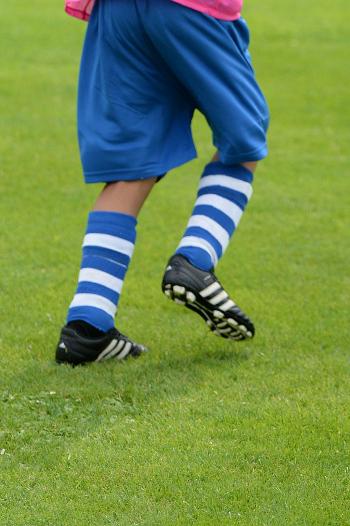What team is that?
Duration/age

There are so many different sports teams, all with their own uniforms. Sometimes they have similar colours and designs. How do you know which team is which?
Talk to your child about the different patterns and colours of the uniforms. Sometimes the colours are the same but the design or pattern is different.
I like to follow Aussie rules. Collingwood and Hawthorn both have vertical stripes on their uniform.
Your sister is playing soccer against Moontown school on the weekend. Their uniform is red and blue too. They have a red top with a blue sash and her top has red and blue stripes.
Sometimes the colour and pattern on the uniform will be very similar and you will need to look closely to see what is different. It might be that the shade of colour is different or the stripe is wider.
Daddy’s team wears dark blue. The other team wear light blue.
Materials you will need
- Your eyes
- Sports team
Alternative tools
- Newspaper
- Television
- Computer or tablet / smartphone
Skills this activity improves
Why does this matter?
Children have a natural sense of wonder about the world around them. Talking about the things you notice around you helps children to make sense of what they observe. It helps them to develop their observation skills and language to describe what they see.
As they begin to notice and compare what is the same or different around them they are developing descriptive language and experimenting with how to ask questions to get more information.
When they compare what is the same or different they will be using mathematical language to describe what they see and to learn new things.
What does this lead to?
Some children are naturally curious and creative, taking risks in their learning. Children who are naturally curious and creative often notice and wonder about what they see around them. They will ask questions and create their own answers. These children have a disposition to be creative and curious.
Talking about and exploring the natural and everyday environment with your child will help them to develop the skills to notice, take risks and ask questions.
When children notice differences and objects around them, they are able to sort and group them by attributes.
Sorting objects into smaller groups helps children to make decisions about how to interact with the objects. The grouping of the objects creates information and data. The information helps to tell us what to do and how to act.
“Our team has fat stripes and their team has very thin stripes.”
Language to use
- Same, different, similar
- Colour, shade
- Design, pattern, feature
- Thick, thin
- Up, down, vertical, horizontal, around
- Stripe, band, sash, star, lightning bolt, badge
- Team, player, sport
- Uniform, guernsey, jersey, jumper, bib, socks, shorts, shirt, skirt
Questions to use
- Do men and women footballers wear the same uniform?
- Does the Port Adelaide school and football club have the same uniform?
- Do all uniforms have the name of the player on the back?
- Why do some players wear long pants?
Useful tips
- You might also like the activities We went walking, Travelling with children and Pattern walk.
- Information about hearing, vision and language development can be found in your child's health record in the Blue Book.
- If you are concerned about your child's hearing or vision talk to your local doctor.
- Remember to talk to your child in your home language.
More ideas
Collect football cards and sort them into different teams.
Variation by age
Three to five year olds
- Design your own uniform for your favourite team.
- Explore how many different teams wear black and white.
- Count how many cricket teams in the world wear blue.
- Create your own sports team and design the uniform.
- See how many different styles of uniform you can find.
Questions to ask
- Can you wear the same uniform to play tennis and netball?
- If Australia’s colours are green and gold why do they sometimes wear blue?
- What would a uniform look like for someone who played canoe polo?
Language to use
- Team, sport, uniform
- Colour, style, pattern
- Design


